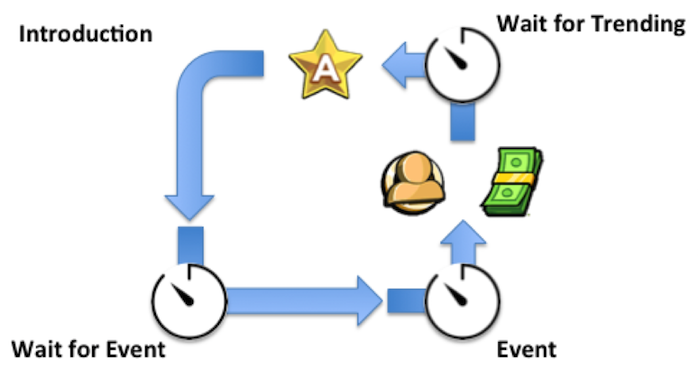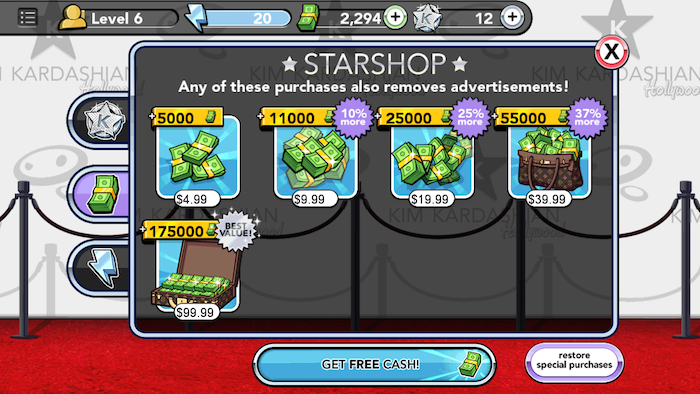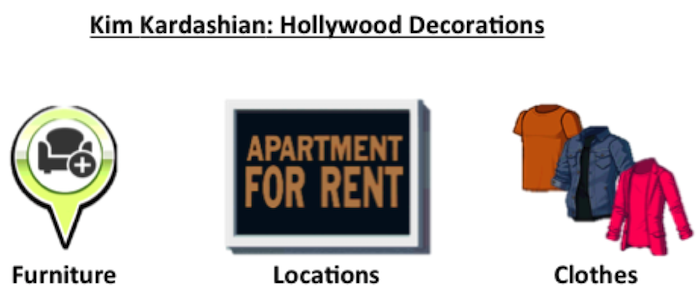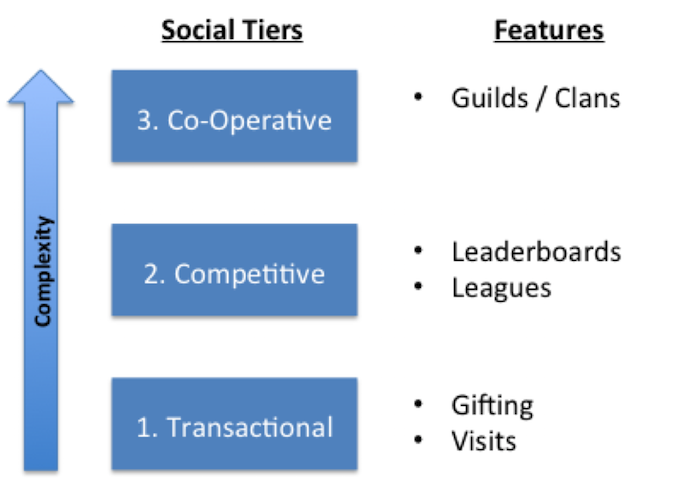· 34 min read
How Kim Kardashian: Hollywood Made the A-List

Joe Traverso
VP of Product at Carnivore, Inc.
Unless you’ve been living under a rock for the past six months, you’re undoubtedly familiar with the phenomenon that is Glu Mobile’s Kim Kardashian: Hollywood (iOS / Android). Even if you haven’t played the game yourself, you’ve almost certainly entered its orbit.
- It inspired intellectual criticism that foreshadowed GamerGate!
- It generated discussion about the value of intellectual property in an industry increasingly sensitive to cost-effective user acquisition!
- It’s one of the biggest game releases of the year by any measure!
- It’s a franchise!
We’re not here to talk about any of that. We’re here to dissect Kim Kardashian (the game, not the person!) and understand its performance. Given all the hype, you’d be forgiven for assuming the game does something magical to retain and monetize users. In fact, there is a lot of magic here, but it’s not the kind of magic that manifests as easily imitable success. The game is a simple one, with very straightforward free-to-play mechanics that have been used in games since FrontierVille in 2011 or earlier.
What it lacks in complexity, however, it more than makes up for in style, substance, and spot-on representation of the Kim Kardashian brand. The team at Glu delivered a high production value gem of a mobile experience that expanded free-to-play gaming to a whole new audience. Without the perfect mix of audience, license, and mechanics, it’s extremely unlikely this game becomes the massive success we see today (and Glu knows this – Kim Kardashian is a re-skin of Stardom: Hollywood, a successful game by most measures but not the breakout hit Kim Kardiashian has become).
That said, there’s still a lot to be learned from a closer look at Kim Kardashian’s mechanics, but it’s important to remember that replicating the success of a game like this without the license would be challenging.
The Core Loop
The Kim Kardashian: Hollywood success is built around a simple core loop. Performing actions in the game – everything from posing at a photo shoot to turning on the catwalk – consumes energy. Different tasks take different amounts of energy to complete, which gives the player something to strategize against (“How many actions can I complete with my remaining energy?”) in day-to-day play. These tasks generate experience points and soft currency for the player, as well as other context-dependent resources we’ll cover in more detail in the Retention section. The energy bar grows with the player’s level, so elder players can have longer sessions than new installs. Waiting for a timer to tick down replenishes the player’s energy so she can get back on the road to fame.

Retention
In free-to-play games, the foundation of strong retention is a clear long-term aspiration that appeals to the game’s target audience. This aspiration is supported by medium-term goals that seem achievable to the player but are far enough away to require continued investment. These medium-term goals are achieved by engaging in an easy-to-understand short-term game progression that rewards the player on a frequent basis for her engagement. The short-term progression is driven by a rock-solid core loop and well-tuned game economy, and strong D1 retention is driven by a tutorial that introduces all of these layers while teaching the player the basics required for success.
Filling in this Mad Lib-like framework will help to see if a game hits all these notes:
- In this game, I: <Core Loop>
- To: <Short-Term Progression>
- That helps me: <Medium-Term Goals>
- That lets me: <Aspiration>
Let’s fill in this framework for Kim Kardashian: Hollywood.
- In this game, I: Use energy to perform game actions
- To: Complete quests and level up
- That helps me: Unlock new locations and cities
- That lets me: Become an A-List celebrity
Kim Kardashian: Hollywood has a clear aspiration that is rooted in reality and supported by solid medium-term goals. Those goals are achieved with a clear short-term progression and a solid core loop. The game’s tutorial introduces all of these concepts while setting the stage for the story to come, in the form of a cliffhanger quest requiring the player to reach the D-List on the Top Stars chart.
For these reasons, it’s likely the game has very strong D1 retention and good short-term retention (D7-D14).
Core Loop – Everything but the (kitchen) sink
If you’ve read any of Miska’s other deconstructs, there’s one thing that might stand out about Hollywood’s core loop. Specifically, the core loop includes no sink for soft currency! Most modern free-to-play games incorporate soft currency sinks into their core loops to keep the game economy in balance. The following examples show some ways in which other successful games incorporate soft currency sinks into their core loops:
- Hay Day: players must spend soft currency to purchase new animals, trees, feed buildings, and crafting buildings to complete orders and earn XP
- Puzzles and Dragons: players must spend soft currency (and even sink monsters) to power up and evolve their team to conquer more difficult dungeons
- Clash of Clans: players must spend both soft currencies to build or upgrade buildings and produce new troops to stay competitive in PVP
As we stated above, a well-balanced game economy is a core driver of retention. Why is that so? The longer the developer manages to keep the soft currency economy in balance, the longer the player will have to engage with the core loop to progress in the game. Once the player no longer has to engage with the core loop to make progress – if she can just log in and immediately use soft currency to purchase whatever new content the game has to offer – she will play the game less and ultimately churn out.
So if Hollywood isn’t sinking its soft currency into the core loop, how does it drive long-term engagement? The answer is that the soft currency is actually one of three currencies that can be earned from playing the game’s core loop! The other two currencies – “blue stars” and “pink hearts”, or progression currencies – are the true drivers of player progression.

Let’s take a look at how these progression currencies are different from the game’s soft currency:
- They reset: every time the player is asked to accumulate blue stars or pink hearts, her balance of the resource starts from zero
- They’re non-transferable: the progression currencies are only good on the appearance – date, quest, etc. – on which they are earned
- They’re content-independent: the player doesn’t get anything other than progress for accumulating these currencies
- They grant progress: stars convert into progress toward the A-List, while hearts convert into progress toward the Top Couples list
- Completion is obfuscated from the player: the player doesn’t know exactly how many actions are required to fill the bar with stars or hearts, giving the developer tuning leverage
In effect, then, each event in the game is its own micro-economy, requiring the player to engage with the core loop as if she is starting over from scratch! This is how Kim Kardashian: Hollywood skirts the issues other games face with soft currency economy tuning, despite the lack of sinks in the core loop. It’s a clever out that allows the player to use soft currency to “peacock” – which grants a small amount of progress in each appearance (see the single “gold heart” above) – instead of to progress, while not breaking engagement with the game.
Short-Term Progression – Quests
Let’s get this out of the way first – Kim Kardashian: Hollywood is perhaps the best-written mobile game of all time. Major kudos to the game’s writers for capturing perfectly the tone and vocabulary of the Millennials that make up this game’s target audience (occasional BSG reference excluded…).
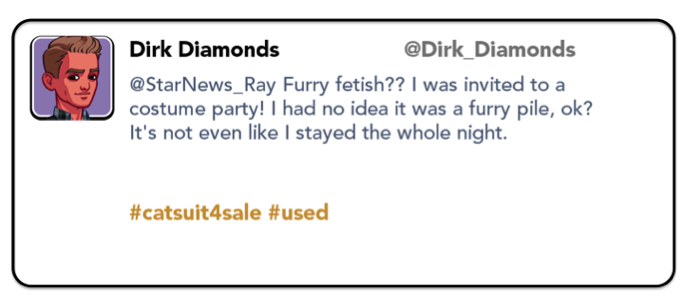
Story is a critical component of retention in narrative-driven games because it hooks the player and helps propel them toward the medium-term goals and the game’s aspiration. In Kim Kardashian, the story is told through a series of quests that drive the short-term player progression.
One of the challenges that quest-based games often encounter is cadence. Putting a new quest in the game takes time – a narrative designer had to author the content, a PM or systems designer had to tune it, QA had to test it, Apple had to review it, etc. – and during that time highly engaged players are churning through the game’s existing quests at a high pace. Keeping up with those hardcore players (and especially payers) becomes very difficult without the quality of the content suffering.
On the flipside, adding tons of new quests into the game every week could be damaging to new player, reactivated player, and low engaged player retention. Those players might be overwhelmed when they see five or more active quests and quit the game in frustration. It’s a delicate balancing act that Glu has pulled off fairly well through its quest system design.
Two quest systems in one
Kim Kardashian: Hollywood’s quest system is actually two systems in one. The first system is the authored content system. These quests are written by designers and incorporated into the game through a content management system. They drive the game’s story forward and keep players motivated toward their medium- and long-term goals.
The second quest system is the grind quest system. This system is an algorithmic pairing of a location, job type, and timer. The player has a choice of timer lengths and can opt to choose none of the quests, in which case the player must wait through (or pay through) an hour-long timer to choose another grind quests. These quests are surfaced to the player using the same systems – the cell phone, the quest UI, etc. – as the authored content, so the difference is almost invisible to the player.

Hollywood’s two-quest system actually solves a lot of the problems inherent to quest-based games:
- Fill content gaps: the algorithmic quests fill in gaps between the story “beats”, meaning the developers need to generate less of the expensive authored content
- Allow player choice: the system allows the players to set their own appointments, so the game can be tailored to their individual style of play
- Recycle existing content: these quests re-use older locations, getting more mileage out of previously-created content and stretching the amount of time between adding new locations and cities
- On-demand quests: the system can fade into the background when the player’s quest queue is full to avoid overwhelming the player with non-story content
Using this two-quest system, Kim Kardashian: Hollywood’s is able to drive player engagement with a smaller authored content footprint.
Timers, timers, timers!
Kim Kardashian: Hollywood’s quests have a lot of timers! While there are many different quest formats, most consist of four phases:
- Introduction: expository dialog that sets up the player’s motivation for completion the quest
- Wait for event: time between quest introduction and the start of the event
- Event: this is where the core loop happens
- Wait for trending: Once the event is over, the player has to wait to find out how many fans she gained or lost
If that seems like a lot of timers, it is! However, each of those timers serves a unique purpose such that the system wouldn’t function as well if any one of them were removed.
Timer one – Wait for event
This timer effectively adds 1.5x to a quest’s duration, stretching out the game’s content while adding an additional opportunity to monetize impatient, paying users. This timer wouldn’t work without the grind quests to fill in the gaps – players wouldn’t have anything on which to spend energy, so their sessions per day and core loop engagement would drop – so the two-system approach is critical here.
Timer two – Event
This timer drives the player to play multiple sessions per day, increasing her engagement with the core loop. If the player cannot complete this phase with a single bar of energy, she either has to wait for her energy to replenish to continue or spend premium currency to buy more energy. If she doesn’t come back before the timer expires, she runs the risk of losing fans for getting a “failing” score on the quests. If this timer didn’t exist, the player would have no motivation to return to the game often to use her newly replenished energy.
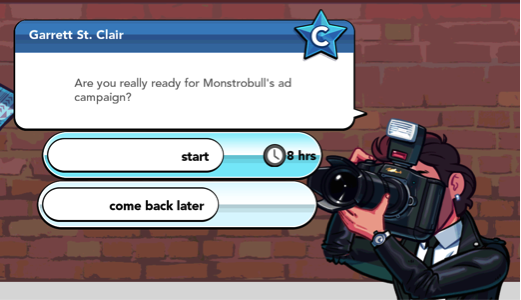
“Why not allow the player to skip this timer outright?” you may ask. Remember, this is the only part of the quest that requires the player to engage with the core loop, so skipping this phase of the game outright is effectively skipping the “playing” part of the game. As the section above noted, core loop engagement is strongly correlated with long-term retention, so it’s critical to avoid giving the player the ability to skip the core loop itself in pursuit of higher monetization.
This phase introduces the game’s concept of pushback. If the player doesn’t get at least three stars, she risks losing fans and therefore progress toward the top of the A-List. It’s an effective reminder to earn those five stars by playing multiple sessions while completing a three-hour or longer event.
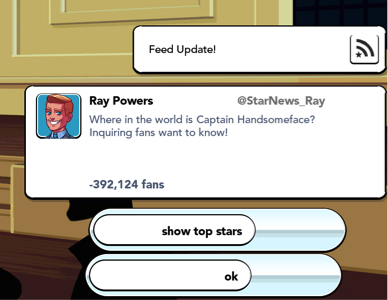
A conversation could also be had here about the value of driving payers to execute multiple small transactions (refilling energy more than once) versus driving payers toward large currency packages (paying a lot to skip an eight hour timer), but that’s a story for another time…
Timer three – Wait for trending
This is perhaps the most interesting timer of all. Once the player’s appearance is complete, she needs to wait until the appearance “trends” to find out how many fans she has added (or lost!).
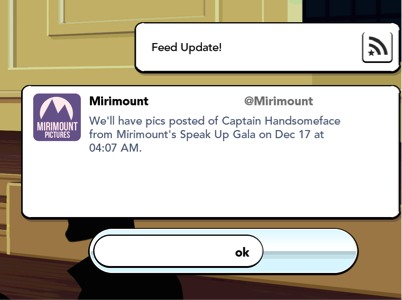
Think about the player’s game state when this timer starts:
- Case One:
- The player has expended some energy to 100% finish a quest
- Case Two:
- The player has just returned to the game and a quest’s timer has expired
In the first case, the player does not have a full energy bar and may be reluctant to start a new quest. It’s possible, then, that without this third quest timer the player may have no active timers. No active timers means no call to action to return to the game – either in the form of a notification or a sense of urgency – so this third timer functions as a next-day retention mechanic.
In the second case, it’s likely two things are true:
- The player has a full or nearly full energy bar
- The player “failed” the quest and will lose fans, and therefore, progress toward the A-List
In this case, giving the player immediate feedback that she failed may cause the player to close the game in frustration without using her accumulated energy, failing to set a return timer. Delaying the bad news may have the effect of giving the player a chance to re-earn some of their lost progress while also re-engaging with the core loop before exiting the session.
Medium-Term Goals – New Locations and Cities
New locations and cities are likely the most expensive content for Kim Kardashian: Hollywood’s developers to create. They also feel like the biggest reward, since the entire game takes place either in a location or on the city maps in transit to the next venue. These changes of scenery – combined with the stories told therein – keep the game fresh for players, especially in a game where the core loop is static.
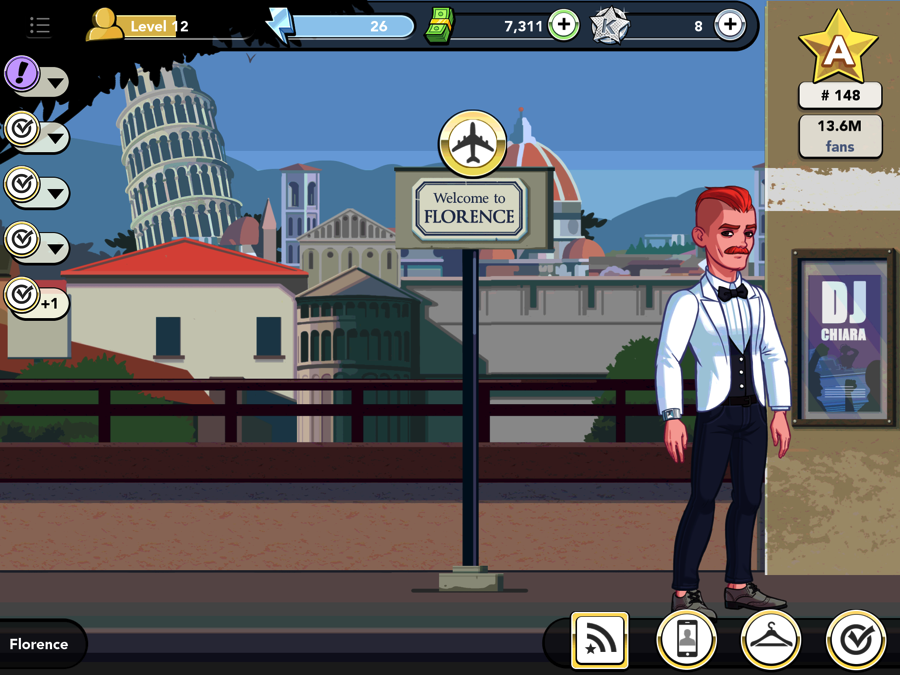
It makes sense, then, that they’re the least frequently added to the game and also the hardest to obtain. As of this writing, there are 10 cities in the game, versus four when the game was released (LA, Miami, Las Vegas, New York) in mid-June. You can actually reach the A-List before you’re able to reach all the cities!
The cities are level-locked, which means players will have to grind on the core loop for a long time to unlock all of them. Many of the venues are quest-locked, which means the player will not only have to engage with the core loop but also work on advancing the game’s story to see all the content the game has to offer.
The game progression- and level-locks these medium-term goals to build on both the core loop and short-term progression. As a result, they drive medium-term retention by acting as mile markers on the player’s journey toward their aspirational goal. The long-term content plan likely revolves around adding more locations to the game, in conjunction with new quests or events.
Aspiration – One path to glory becomes two (or more!)
The overarching goal of Kim Kardashian: Hollywood is to reach the A-List. It’s a super clear aspiration that perfectly aligns with the fiction of the world and should be familiar to Kim’s fans and casual players alike.
Let’s take a look back and see how all these systems build upon one another to drive players toward this aspiration:

The game makes it as easy as possible for the player to understand how to achieve her aspiration – complete game actions to earn stars, earn stars to complete quests, complete quests to earn fans, earn fans to climb to the A-List. This simplicity is a key reason this game has been able to attract and engage a whole new audience of mobile game players, is a big part of the game’s appeal, and acts as a key driver of its ability to retain users for the long-term.
Of course, this progression begs an important question: What happens once the player reaches the A-List? Unlike other content-driven games, which can simply add more quests to the end of the progression, Kim Kardashian: Hollywood is limited by the realities of celebrity. The fact is, the game can’t invent a new list for players to aspire to reach. Doing so would destroy the suspension of disbelief the game has worked so hard to create.
So how has Glu attempted to mitigate this problem? Two ways:
A-List Granularity
Once you’ve reached the A-List, the game’s quests shift focus. At this point, it’s all about reaching the Top 100 stars on the path to becoming the #1 star. The benefit to this additional granularity is it re-focuses the user on the chart climb, which should drive engagement with the core loop.
The potential downside is that, eventually, players will become the #1 star. Sure, Glu could continue to add more stars to the top of the list. The risk is that this will feel to the player like Glu keeps moving the goalposts, causing them to wash out of the game since they’ll never be able to reach “the end”.
Which brings us to…
New Progressions
Since launch, Glu has already added two new progressions to the game – one permanent and one temporary. Both progressions have the goal of driving players to stay engaged with the core loop for as long as possible.
Top Couples
At launch, the Romance system felt a bit like a hanging chad. Sure, there were quests that drove player to find a love interest, but the system itself never felt like much more than “bars going up”.
With a recent update, the system became much more robust. In fact, it effectively mirrors the “Top Couples” system and acts as a secondary progression system.

Whether it’s as effective as the Top Stars system at driving engagement with the core loop remains to be seen, but one of the big hurdles it faces is that it’s not directly tied into the game’s quest system and, therefore, the core progression. Glu has attempted to mitigate this by aggressively having the player’s romantic interests call to ask for dates, but that comes across as desperate (especially when they break up with you equally aggressively…).
Additionally, for players that haven’t already reached the top of the A-List, the Top Couples chart divides their focus. Given the choice between pushing to be the #1 celebrity – which is supported by the quest system and motivated by the game’s story – and becoming a Top Couple, most players would likely choose the former. There is some risk that exposing Top Couples to all players could cause some of them to lose focus on the core progression and disengage from the core loop.
Regardless of how the Top Couples list pans out, Glu isn’t hedging its bets…
Events
Glu has (finally) followed in the footsteps of nearly every successful casual free-to-play game maker and added an event system to Kim Kardashian: Hollywood. So what makes a good event system?
- New economy: a new resource economy resets the player to zero, leveling the playing field and ensuring no payers are able to skip ahead
- Tiers with escalating rewards: gives low engaged players a sense of accomplishment while encouraging across-the-board increases in sessions per day to earn all rewards
- Competition: allows whales to push to be #1 and stay on top, driving tons of spend
- Timers: expiration encourages higher engagement while clearing the system for future events
This is similar to the approach that Kim Kardashian took with its first new events. The screen below displays the Product (RED) event. To play the event, the player must complete actions for a chance to earn a new currency, “red stars,” that fill up a progress bar:

Let’s use our framework to see how the Product (RED) event did at driving re-engagement with the core loop:
New economy: Hit
The “red stars” were a new resource added to the game specifically for this event, that the player can only get from re-engagement with the core loop
Tiers with escalating rewards: Hit
New prizes are earned at every tier, giving low engaged players an achievable goal while allowing high engaged players and payers to grind for that amazing scarf that brings the whole ensemble together
Competition: Miss
For players that achieve the highest tier prize, there’s no motivation to continue earning “red stars” to be the best in the world
Timed: Hit
The feature expires, encouraging a period of high engagement and creating opportunities for desperate players to spend.
These types of event systems typically work very well in simulation-style games (think Hay Day) where the player’s progression is decoupled from the tasks required to complete the event. In those types of games, the player either has to make a choice to consciously focus on the event – should I bake bread for the event? – or her progression – should I sell wheat to complete orders to save up for this BBQ? – and the only way to do both is to spend money or double (or more!) engagement.
In Kim Kardashian: Hollywood, the quests ARE the progression, and players will make progress just by playing through the existing story. Thus, it’s possible that the kinds of players that would normally convert to payers to complete an event like this are already highly engaged. They may complete events without any changes to their regular play patterns.
It’s possible, then, that these events underperform their potential because of the simplicity of the game’s core loop. It will be interesting to see if future events change up the formula to drive the engagement increase the developers are looking for.
Regardless, given that there are more events coming in December, it appears that this system is the path forward for Kim Kardashian: Hollywood.
Monetization
Kim Kardashian: Hollywood’s approach to monetization is straightforward. It hits many of the notes you’d expect from a casual free-to-play game – speed-ups and decoration – with a couple unique twists.
Speed-Ups – The basics
There are plenty of opportunities in Kim Kardashian: Hollywood for players to accelerate their progress.
Energy refill
Instead of waiting for the energy timer to refill, the player can purchase different tiers of energy refills to continue to make progress. All energy purchases are made in premium currency. It seems likely that energy drives a high percentage of revenue for the following reasons:
- Price: it costs nearly a full star per energy (players get five energy per six stars) and each star costs around $0.10, so at level 12 a full energy refill costs over $2
- Risk of lost progress: the player can lose progress if she does not complete an appearance with four stars or greater, which is a major incentive to spend on energy as the timer ticks down
- Un-skippable appearance timer: the only way to make progress quickly is to buy energy
This is balanced against the fact that the game’s energy tuning is fairly generous, and it’s not too difficult to complete even the hardest appearances without too much effort. Most eight-hour events can be completed in just a few sessions, while many of the one-hour events can be completed with a single energy bar.
Wait for appearance
As mentioned in the Quest section above, players often have to wait for appearances to start. The player can pay to access those appearances sooner by paying premium currency. At this late stage, the game has plenty of activities for the player to do at any given point, so she would have to be incredibly invested in the story to feel an urge to pay to skip this timer.
It seems likely, therefore, that this timer is largely meant to drive return behavior as opposed to monetization.
One best practice this feature incorporates is time-based discounts. Essentially, as the timer to the appearance’s start ticks down, the cost to skip declines.
Typically, the development team A/B tests a feature like this with the following hypothesis:
- Discounting the price over time encourages a larger number of payers to spend money at a lower dollar per transaction, netting more revenue
Of course, the alternate could be true – you may get fewer payers to pay without discounting, but at a high enough dollars per transaction to generate more revenue than from the increase in payers in the discounting case. You’ll also want to check for other factors (e.g., the non-discounted price cannibalizing other features, etc.) so it’s in your best interest to A/B test a feature like this if possible.
Pay to Skip
Kim Kardashian: Hollywood allows players to exchange real money for soft currency. There are a few moments in the game progression where, in order to complete a quest, the player must spend a large amount of soft currency. If the player has an insufficient amount of soft currency, she can spend real money to purchase more.
Given the small number of places in the progression where there’s a high soft currency gate, it seems likely these gates are largely meant to drive players to grind on the core loop (with payer conversion a bonus). In fact, that goal is typical of many quest-driven free-to-play games – price-per-dollar on soft currency is purposefully set high to make grinding look attractive while also making the premium currency exchange rate look favorable by comparison. That said, Kim Kardashian: Hollywood’s soft currency is tuned pretty tight, so it’s possible a fair few players will pay to skip the soft currency grind.
It’s possible Kim Kardashian: Hollywood’s audience – remember, this may be their first free-to-play game – is willing to spend real money on soft currency decorations as well, driving up the amount of pay to skip spend. However, it seems much more likely they’d spend on the paid decorations outlined below.
Decoration – Missed opportunity
Decorations comprise the other major source of monetization in Kim Kardashian: Hollywood. They consist primarily of the following:
It seems likely, given the game’s target audience, that the decoration game does indeed drive a large chunk of the game’s revenue. Putting the player’s avatar front-and-center certainly encourages players to invest in her appearance. However, that doesn’t mean the game’s decoration system is as optimized as it can be.
The one clear miss is that none of these decorations are explicitly required – outside of a few quests – by the game. They do provide a passive benefit that gives players a head start on appearances – the Kustomize screen even has a score for “Professional Bonus” and “Romantic Bonus” – but even that is capped at a single star or heart and the game is vague about how the benefit is earned and applied. The game doesn’t even show the player how many bonus points are earned until after the decoration is purchased!
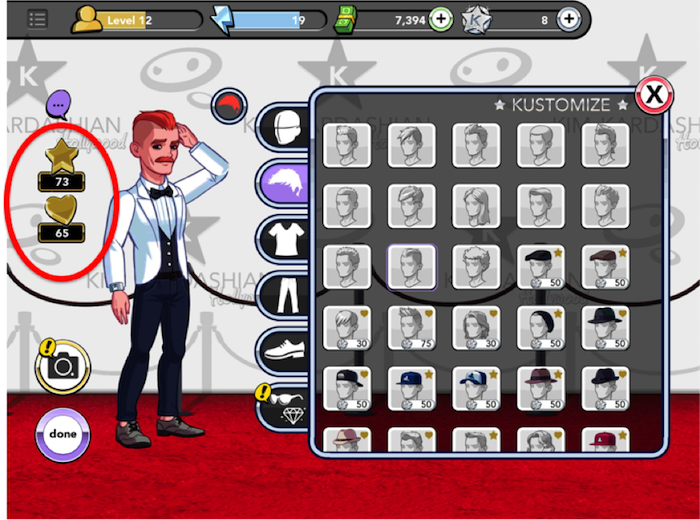
If the player doesn’t understand how a system works, she’ll be much less likely to spend money to “beat” it.
So what could they have done better? One would need look no further than Glu’s own Deer Hunter game for a few potential ideas. One thing Deer Hunter does very well is map-based weapons. Essentially, the player’s weapons – both paid and free – are only good on a single map. Each map, the player has to start over from scratch and re-upgrade (or re-purchased) to complete each map and continue to progress through the game.

How could Kim Kardashian implement a similar system? One method could be to gate story-based appearances by Professional score. In order to get a sufficient amount of Professional score, the player would have to purchase most if not all of the available fashions in a particular city. To afford that wardrobe, the player would need to grind on the algorithmic quests to earn sufficient soft currency. Premium fashions would allow the player to skip the grind and progress quickly through the story.
Then, once the player completed that chapter of the story and reached the next city, both payer and non-payer Professional scores would be insufficient to unlock the newest story quests. For non-payers, the grind would start over as they work to buy the new city-specific fashions. For payers, they’d need to pay again to purchase all the new premium fashions.
Fortunately, building decorative content for Hollywood is cheap, so the developer likely won’t exhaust this revenue stream in the near future. Still, by linking decorating to the core game, Kim Kardashian: Hollywood could drive higher sessions per day engagement while creating a whole new category of potential payers.
Odds and Ends
Kim Kardashian: Hollywood has a couple really interesting flows for driving players to spend premium currency.
Premium items on the game board
Players love animals. Kim Kardashian: Hollywood puts sad animals on the player’s game board and offers them the chance to “adopt” them for premium currency. Money: MADE!

Seriously, though, it’s a best practice to show players what they get for their money. What better way than to put premium purchase items in the player’s game space?
Break up, network, and flirt
This one’s a bit contentious. If the player doesn’t go out on a date with her sweetie for a long enough period of time (exactly how long is not clear to the player), the player gets a “pay money or we’re through” phone call. Flows like this have fallen out of favor in social games of late because they’re retention killers – there’s no good choice here, and it’s possible for a non-paying player to lose days or weeks of progress if she doesn’t pay up.

Perhaps Kim Kardashian: Hollywood players are new enough to social games to not yet have developed sensitivity to these tactics? That’s certainly a possibility. There are other parts of the game where the player is presented a premium currency choice without a ton of information:
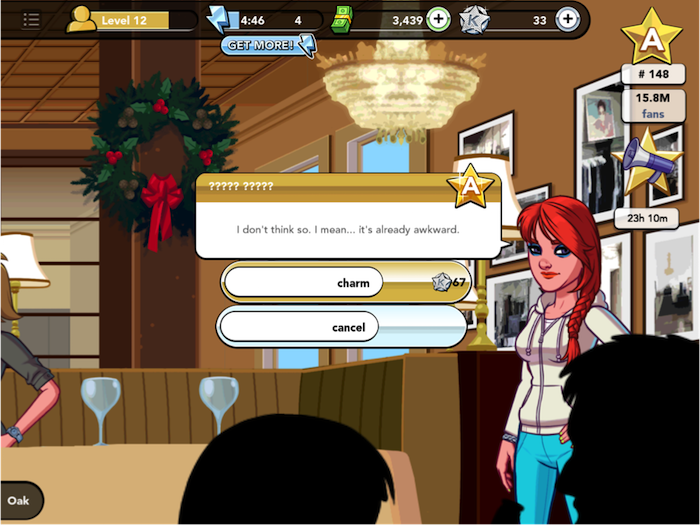
In the above case, the player can’t add this NPC to her friends list without paying real money. Adding the NPC means you can take her on dates or bring her to professional events. The game doesn’t explicitly spell out that using an A-Lister in this way will make the player progress faster, but it’s reasonable to assume that’s the case.
It’s hard to shake the opinion that this is a cheap cash-in, however, meant to take advantage of unsophisticated free-to-play gamers. Such a case is supported by the fact that “breaking up” doesn’t seem to do much in the game. If you don’t spend the premium currency, your progress with that romantic interest is put on hold until you pay up. Same with the contact list example – once you’re high enough level, these NPCs will literally beg you to become contacts:

The fact that the game does such a poor job explaining these mechanics suggests that they’re in there primarily to take advantage of unsophisticated free-to-play gamers.
Social
Asynchronous social games tend to have three tiers of social play. They are:
- Transactional social is the most basic, and is meant to drive viral growth and create beneficial social loops between players to encourage engagement
- Competitive social is more complex, and is meant to drive engagement while encouraging players to push one another to be the best (driving whale behavior)
- Co-operative social is the most complex, requiring grouping systems to create social reliance that drives very high levels of engagement and (when combined with competition) spend
You may be disappointed to discover that a game so suited to competition – the A-List is a perfect metaphor for a leaderboard! – has little more than the bare minimum social features, and even those features suffer in their execution.
That’s not to say the game doesn’t do anything interesting with the social features it does have, but it’s a shame to see such a huge missed opportunity.
Invite Flows – Facebook and Twitter!
Kim Kardashian: Hollywood extends its in-game Feed metaphor to the real-world with its Twitter integration. It’s one of the few games that’s leveraging in-game Twitter integration to drive viral reach.

It seems unlikely that Twitter is directly sourcing many installs for the game, but there is no doubt it contributed to the massive word-of-mouth the game generated when it was first released. Glu’s got one of the best UA teams in the business, so it’s hard to see how this didn’t end up being a net positive for the game.
Over and above the Twitter integration, the game has the now-standard Facebook integration to invite friends. Fortunately, Glu ported the game to the Facebook canvas, so it will be able to keep its custom friend selector on mobile once Facebook forces the shift to API 2.0.
Gifting – Not for free!
Players in Kim Kardashian: Hollywood can gift new outfits to one another. Getting a gift triggers a push notification from the game, encouraging the gifted player to open the app and claim her prize.
The problem? These gifts aren’t free!

It’s hard to imagine many people take advantage of this feature. Most social games set aside a small number of resources – consumables, usually – as “giftable” resources. These resources usually can’t be purchased and have a hard inventory limit to avoid exploits.
The fact that Hollywood doesn’t have a consumable game somewhat forces its hand, but it’s hard not to see they’re leaving some free installs and engagement on the table with such an inefficient gifting flow.
Visits
Once you’ve got some friends playing Kim Kardashian: Hollywood, the game treats them like any other character you might encounter in the game. You can date them, take them on professional appearances, and even see them on the Fame List.
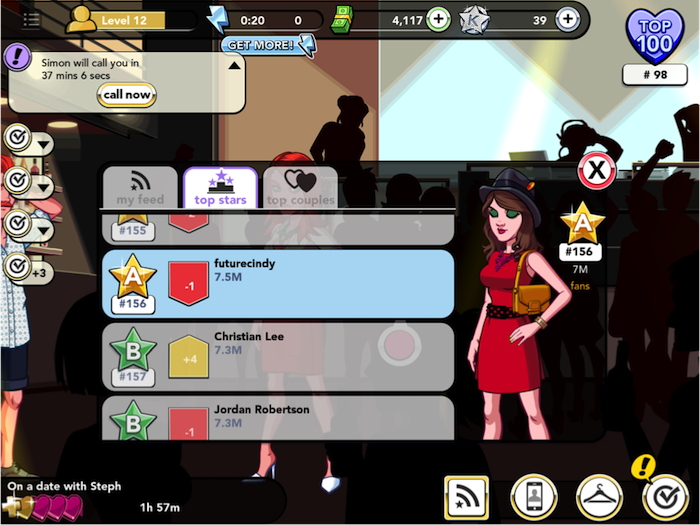
Unfortunately, that’s the extent of visiting in Hollywood. The friend doesn’t get any rewards or even notification that another player used her avatar. Either of those could be used to drive a beneficial engagement loop between the two players.
For a game about relationships and their influence on fame, this seems like a huge missed opportunity to drive reciprocal social behavior that could improve the game’s engagement.
Competition? Cooperation?
Unfortunately, neither true competition nor co-operation is in the game in its current state. This is truly a shame, as the game seems tailor-made for these features. One can easily imagine:
- Competition
– Compete with your friends (using the event framework) to win a role in a new movie (or a sponsorship deal, etc.)
– Worldwide, real-time Top Stars list (similar to Clash’s all-time individual leaderboards)
- Cooperations
– Create your own talent agencies with your friends and work together to increase you mutual fame and wealth
– Strategize your investments – which talent to send to each audition – using in-game chat
– Cooperation-specific leaderboard to track your progress versus the world
Now, the argument could be made that competition isn’t a fit for the game’s target audience. This seems unlikely, as the core progression of the game is essentially competition against the Top Stars list (and that one star in particular – Dirk Diamonds for the men and Willow Pape for the women – that is the thorn in the player’s side from the beginning). If the game is driving strong retention with its Top Stars progression, competition seems like a no brainer.
One has to assume that both cooperation and competition are on the roadmap for Kim Kardashian: Hollywood. Both features would be huge engagement drivers while creating massive spend opportunities for the game’s whales.
Wrap-Up
Kim Kardashian: Hollywood is an incredible achievement. It’s a free-to-play game with super high production values – both the art and the copywriting are excellent – that has managed to attract a whole new audience to mobile games. Befitting the new-to-mobile audience, the game keeps things simple and straightforward while incorporating a few old tricks to stretch out the content grind and encourage players to monetize. It manages to try a few new things with social but ultimately falters even on the basics, while leaving plenty of room for major improvement – in the form of competition and co-operation – in future updates.
With the incorporation of events, the game is much less reliant on the content grind – producing new quests, locations, cities, and decorations – than it was in the past to generate both engagement and revenue. Effectively, events require no more than a new reward at each completion tier, drastically reducing the content grind. This should hopefully give the developers a bridge until they’re able to incorporate systems that transcend the transactional features that form the game’s social core.
You can find the original article here.
